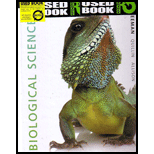
Concept explainers
Introduction:
The reproduction in which the offspring arises from a single organism and genes of only one parent are inherited is called asexual reproduction. The fusion of gametes, changes in the chromosomes, and crossing over are not involved in asexual reproduction.
Answer to Problem 1TYK
Correct answer:
The term parthenogenesis refers to a mode of asexual reproduction, which involves the development of the offspring from unfertilized eggs.
Explanation of Solution
Explanation/Justification for the correct statement:
Option (a) is given as parthenogenesis. The reproduction process where the offspring develops from an ovum without fertilization is called as parthenogenesis. It is the process where offsprings are generated by mitosis, or by meiosis, or by the fusion of two of the products of meiosis. Parthenogenesis occurs in a wide diversity of lineages, including certain invertebrates, fishes, lizards, snakes, and birds. This process usually is observed in some invertebrates, fishes, lizards, snakes, birds, and plants. It is a form of asexual reproduction. The embryos develop without fertilization. Hence, Option (a) is correct.
Explanation for incorrect answers:
Option (b) is given as budding. Budding is also a type of asexual reproduction. The new organism develops from a bud or an outgrowth with the help of cell division. The yeast cells also produce a small bulb-like structure called the bud. So, it is incorrect.
Option (c) is given as regeneration. The process of restoration, renewal, and growth is called regeneration. The process of regeneration is used in cells, organisms, genomes, and others. In some animals, some parts of the body can be regenerated. So, it is incorrect.
Option (d) is given as fission. The fission is the process of division of a single cell or an entity, which generates two or more parts. These parts develop into separate entities independent of each other. Most of the cells undergo fission. A single-celled organism such as Paramecium and Amoeba undergo binary fission. So, it is incorrect.
Hence, options (b), (c), and (d) are incorrect.
The type of reproduction, in which the offspring develops from the unfertilized eggs, is called parthenogenesis.
Want to see more full solutions like this?
Chapter 50 Solutions
Biological Science
- Outline the negative feedback loop that allows us to maintain a healthy water concentration in our blood. You may use diagram if you wisharrow_forwardGive examples of fat soluble and non-fat soluble hormonesarrow_forwardJust click view full document and register so you can see the whole document. how do i access this. following from the previous question; https://www.bartleby.com/questions-and-answers/hi-hi-with-this-unit-assessment-psy4406-tp4-report-assessment-material-case-stydu-ms-alecia-moore.-o/5e09906a-5101-4297-a8f7-49449b0bb5a7. on Google this image comes up and i have signed/ payed for the service and unable to access the full document. are you able to copy and past to this response. please see the screenshot from google page. unfortunality its not allowing me attch the image can you please show me the mathmetic calculation/ workout for the reult sectionarrow_forward
- Skryf n kortkuns van die Egyptians pyramids vertel ñ story. Maximum 500 woordearrow_forward1.)What cross will result in half homozygous dominant offspring and half heterozygous offspring? 2.) What cross will result in all heterozygous offspring?arrow_forward1.Steroids like testosterone and estrogen are nonpolar and large (~18 carbons). Steroids diffuse through membranes without transporters. Compare and contrast the remaining substances and circle the three substances that can diffuse through a membrane the fastest, without a transporter. Put a square around the other substance that can also diffuse through a membrane (1000x slower but also without a transporter). Molecule Steroid H+ CO₂ Glucose (C6H12O6) H₂O Na+ N₂ Size (Small/Big) Big Nonpolar/Polar/ Nonpolar lonizedarrow_forward
- what are the answer from the bookarrow_forwardwhat is lung cancer why plants removes liquid water intead water vapoursarrow_forward*Example 2: Tracing the path of an autosomal dominant trait Trait: Neurofibromatosis Forms of the trait: The dominant form is neurofibromatosis, caused by the production of an abnormal form of the protein neurofibromin. Affected individuals show spots of abnormal skin pigmentation and non-cancerous tumors that can interfere with the nervous system and cause blindness. Some tumors can convert to a cancerous form. i The recessive form is a normal protein - in other words, no neurofibromatosis.moovi A typical pedigree for a family that carries neurofibromatosis is shown below. Note that carriers are not indicated with half-colored shapes in this chart. Use the letter "N" to indicate the dominant neurofibromatosis allele, and the letter "n" for the normal allele. Nn nn nn 2 nn Nn A 3 N-arrow_forward
 Concepts of BiologyBiologyISBN:9781938168116Author:Samantha Fowler, Rebecca Roush, James WisePublisher:OpenStax College
Concepts of BiologyBiologyISBN:9781938168116Author:Samantha Fowler, Rebecca Roush, James WisePublisher:OpenStax College
 Comprehensive Medical Assisting: Administrative a...NursingISBN:9781305964792Author:Wilburta Q. Lindh, Carol D. Tamparo, Barbara M. Dahl, Julie Morris, Cindy CorreaPublisher:Cengage LearningEssentials of Pharmacology for Health ProfessionsNursingISBN:9781305441620Author:WOODROWPublisher:Cengage
Comprehensive Medical Assisting: Administrative a...NursingISBN:9781305964792Author:Wilburta Q. Lindh, Carol D. Tamparo, Barbara M. Dahl, Julie Morris, Cindy CorreaPublisher:Cengage LearningEssentials of Pharmacology for Health ProfessionsNursingISBN:9781305441620Author:WOODROWPublisher:Cengage





